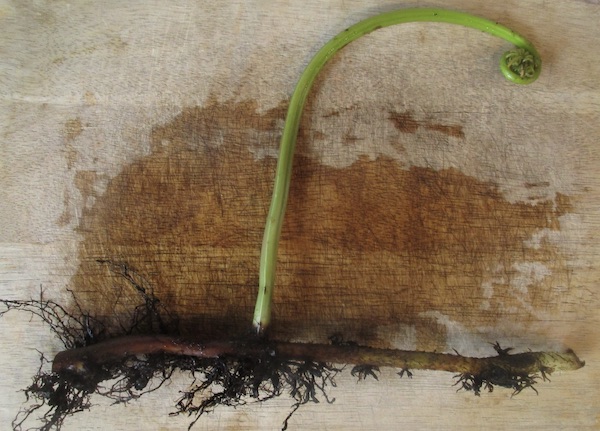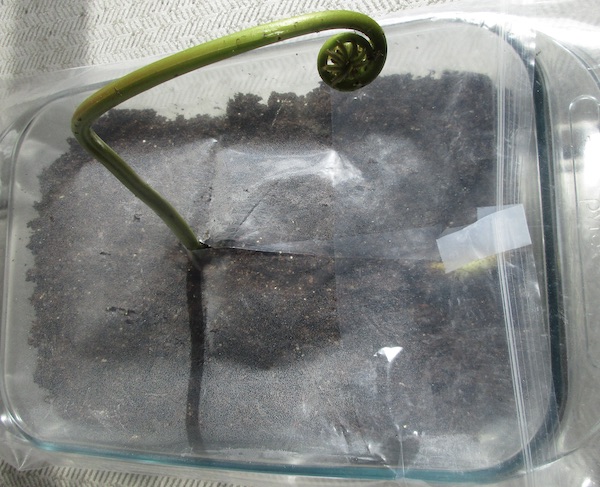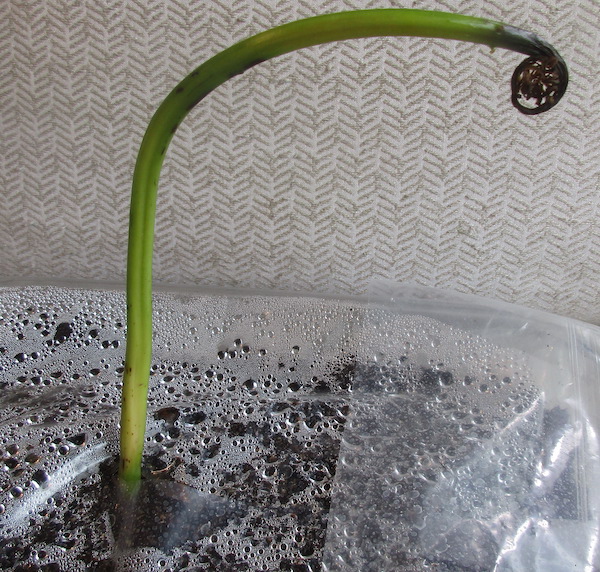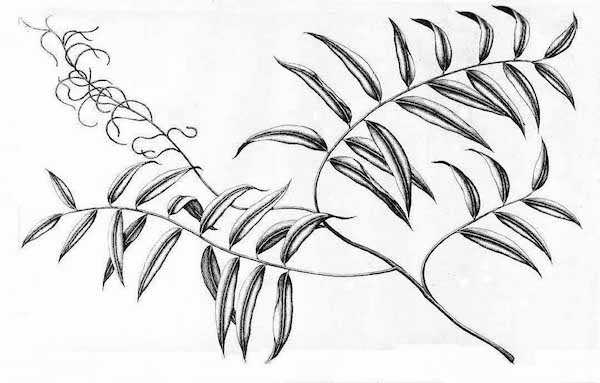Plant of the Month: May 2024
|
| Climbing Fern |
| Stenochlæna palustris (Burm. fil.) Bedd. |
ASPLENIACEÆ (BLECHNACEÆ) ; Spleenwort Family
|
| This month I acquired a new houseplant from the tropics and subtropics, called variously the Climbing Fern, Climbing Swamp-Fern, Giant Vine-Fern, Liane Fern, or Vine Fern. In China it is Guang Ye Teng Jue (光叶藤蕨) ; in Vietnam Rau Choai; in Thailand Prong Suan. The 1841 generic name derives from Greek stenos, and chloena, meaning narrow cloak, referring to the narrow edge of the fertile fronds. Its fertile fronds are contracted strongly. |
| It is a native of permanently damp open places & swamps in India, Nepal, S China, Burma, peninsular Malaysia, Singapore, New Guinea, extreme N Australia & W Pacific as far as Fiji, in full sun or in shade. Its pencil-like rootstock (rhizome) scrambles up and wraps around trees, often reaching the tops, and can reach more than 60 feet. |
| Its glossy, bright green, tough-textured and rigid fronds are 1 to 2.5 feet long usually; at most to 5.75 feet in length. Its copper-reddish, young sterile fronds are harvested commonly and consumed as raw or cooked vegetables in countries such as Malaysia, Indonesia, Thailand, the Philippines & New Guinea. High contents of phenolic constituents, including anthocyanins, and high specific metal chelating activity in the young fronds highlight its potential as a functional food. |
| The sterile fronds are always abundant, but now and then (as when drier) the plant makes fertile fronds, narrower and much different looking. These are not eaten. |
| In the USA, It has been sold since at least 1958 as an "exotic house plant" by the Julius Roehrs company of New Jersey. Specimens are in many greenhouses and conservatories. My Seattle living room window faces east. I try to keep the room humidity at 60% and the temperature at least 65 degrees F. I placed the rhizome piece I acquired in a glass lasagna pan. The rhizome was covered with potting soil, except its tip. Then plastic bags were placed over the surface to maintain humidity. I expect its fiddlehead to uncoil gradually into a frond. Later on, this webpage can show updated photos. My motive is to learn whether an edible tropical fern such as this is worth growing. I may need to train it up a mossy pole; its present "pot" will not suffice as it enlarges. |
My still-unfinished edible houseplants book will include 56 genera of pteridiphytes ("true" ferns of botanists) in ten families, and still more genera of "fern allies" and near relatives called ferns. Though 87.5 percent of the 56 genera have species reported edible, most of these, for one reason or another, are likely if not certainly less valuable as indoor food souces —at least in my home conditions. Had I a greenhouse, then far more options would exist, because ferns thirst and need high humidity. Another tropical edible climbing fern genus is Lygodium, that I may trial by and by. To my thinking, the value of these is they can make new fronds all year --instead of just once annually like most clumping ferns. And if I eat them regularly as "pruning," then they will not grow too large.
|
The black & white drawing below is from Georg Eberhard Rumphius' Herbarium Amboinense (1741 - 1750), to show how markedly different the fertile fronds appear. Note that its sterile fronds are sometimes subtly toothed near their tips.
Back |

Stenochlæna palustris rootstock on my cutting board ; photo by ALJ
|

Stenochlæna palustris covered with potting soil ; photo by ALJ
|

Stenochlæna palustris under plastic ; photo by ALJ
|

Stenochlæna palustris under plastic ; photo by ALJ
|

Stenochlæna palustris fiddlehead tip dying; June 16th ; photo by ALJ
|

Stenochlæna palustris drawing from 1750 ; photo by ALJ
|
|
|

